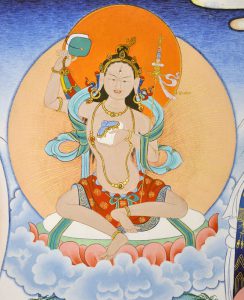
The Shangpa Kagyu, which traces its origins back to the eleventh century, is one of the Eight Great Practice Lineages of Tibet. The Shangpa teachings find their source in Buddha Vajradhara, who in the case of the Shangpa transmitted the lineage to the great Indian yogini Niguma. Both she and the yogini Sukhasiddhi passed the teachings on to the Tibetan disciple, Khyungpo Naljor who, after travelling to India seven times, eventually settled in the Shang Valley in Central Tibet, which is how this tradition came to be known as the Shangpa. Thenceforth the lineage teachings and oral instructions continued to be passed down through an unbroken continuity of masters and disciples. For this reason the Shangpa also bears the name ‘Kagyu’, (Ka means “speech”, and refers to the scriptures of the Buddha and the oral instructions of the guru; and gyu means lineage or tradition), rather than because it is one of the Dagpo Kagyu Schools, which stem from Gampopa. The Shangpa has been held both as an independent transmission and also by many masters of the Dagpo Kagyu, Nyingma, Sakya and Gelug traditions.
The first seven lineage holders, from Vajradhara until Chöje Sangye Tönpa, transmitted the lineage to one disciple only. These masters are known as the “Seven Jewels” of the Shangpa Kagyu. From these masters onwards the transmission spread more widely, and four main Shangpa lineages developed: the Jonang, Thanglug, Jagpa and Nyangme Samding lineages. All four continued to transmit the Shangpa teachings known as the Five Golden Dharmas, which are likened to a tree with its roots, trunk, branches, flowers and fruit. ‘The Root’ is The Six Yogas of Niguma; ‘The Trunk’ is The Mahamudra Reliquary; ‘The Branches’ are Carrying Three Aspects on the Path; ‘The Flowers’ are White and Red Kechari; and ‘The Fruit’ is Deathlessness and Non-Deviation.
Other transmissions include, The Six Yogas of Sukhasiddhi, The Combined Practice of Four Deities, The Inseparability of the Lama and the Protector, The Five Tantra Classes, Hayagriva according to Khyergangpa’s tradition, and The Thirteen Distinct Transmissions of the Six-armed Protector.
Except for the Jonang tradition, the Shangpa Kagyu has relied more upon individual lines of transmission than centralised institutional structures and, unlike the other Sarma schools, has largely refrained from the building and running of monasteries. Most of its principal lineage holders chose to live as hidden yogis, devoting themselves to many years of solitary retreat while remaining free of the many ties and responsibilities that come with administrating large institutions.
While this may have been so, the transmission of the Shangpa tradition – its teachings, practices and realisation – has run both independently, and throughout all lineages of Tibetan Buddhism, particularly the Dagpo Kagyu. In the nineteenth century, the Great Jamgon Kongtrul Lodrö Thaye received all existing Shangpa transmissions and passed them on to his students at his two main seats of Tsadra Rinchen Drak and Dzongshö. In addition, he also transmitted them to the Second Tenga Rinpoche of Benchen monastery and the Tsabtsa Drupgon of Tsabtsa monastery in Kham.
Outside of Tibet, the previous Kalu Rinpoche, Bokar Rinpoche and Kyabje Tenga Rinpoche were well known lineage holders.
